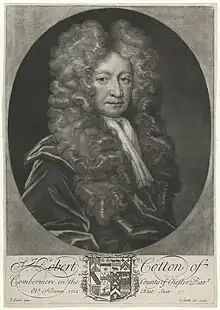

Sir Robert Cotton, 1st Baronet (c. 1635 – 18 December 1712) was an English Whig politician. He was Member of Parliament (MP) for Cheshire from 1679 to 1681 and from 1689 to 1702.[1]
He was the eldest surviving son of Thomas Cotton of Combermere Abbey, Cheshire, and his wife Elizabeth Calveley, daughter of Sir George Calveley of Lea (aka Calverley). His ancestor Sir George Cotton was granted Combermere by Henry VIII in about 1541. In 1677 he was made Baronet of Combermere in the County Palatine of Chester.[1] After he was accused of treasonable correspondence with the Electress of Hanover, Sophia, in 1685 he was committed to the Tower of London by the Earl of Sunderland, Secretary of State for the Southern Department. He was eventually cleared of the charges in part by the testimony of some of his political opponents.[2][1]
In politics he was a staunch Whig and opponent of James II.[1] He welcomed the Glorious Revolution but did not play a leading role in politics thereafter. Historians consider his voting pattern to be proto-"Country", which irked some of the less independent Whigs of his era. He was considered a principled and honest man.[3]
In 1684 he married Hester Salusbury, daughter and sole heir of the Royalist politician and soldier Sir Thomas Salusbury and his wife Hester Tyrrell. As a result, the family's seat at Combermere Abbey was enhanced with the Llewenni Estate in Denbighshire, northeast Wales.[4] The couple had the following known issue, (out of a possible sixteen children in all):
- Hugh-Calveley Cotton, who married Mary, only daughter and heiress of Sir William Russell, 1st Baronet of Langherne and his wife Hester Rouse.
- Hugh-Calveley died before his father and left an only daughter, Catherine, who married Thomas Lewis, Esq. of St Pierre, Monmouthshire.[5]
- Sir Thomas Cotton, 2nd Baronet, of Combermere
- Mary Cotton, who married Sir William Fowler, of Harnage Grange.[6]
- Anne Cotton, who married Sir Thomas Taylor, 1st Baronet; she was the grandmother of the 1st Earl of Bective
- Arabella Cotton, who married Henry Tichborne, 1st Baron Ferrard and had issue.
Ancestry
| Ancestors of Sir Robert Cotton, 1st Baronet, of Combermere | |||||||||||||||||||||||||||||||||||||||||||||||||||||||||||||||||||||||||||||||||||||||||||||||||||||||||||||||||||||||||||||||||||||||||||||||||||||||||||||||||||||||||||||||||||||||||||||||||||||||||||||||||||||||||||||||||||||||||||||||||||||||||||||||||||||||||||||||||||||||||||||||||||||||||||||||||||||||||||||||||||||||||||||||||||||||||||||||||||||||||||||||||||||||||||||||||||||||||||||||||||||||||||||||||||||||||||||||||||||||||||||||||||||||||||||||||||
|---|---|---|---|---|---|---|---|---|---|---|---|---|---|---|---|---|---|---|---|---|---|---|---|---|---|---|---|---|---|---|---|---|---|---|---|---|---|---|---|---|---|---|---|---|---|---|---|---|---|---|---|---|---|---|---|---|---|---|---|---|---|---|---|---|---|---|---|---|---|---|---|---|---|---|---|---|---|---|---|---|---|---|---|---|---|---|---|---|---|---|---|---|---|---|---|---|---|---|---|---|---|---|---|---|---|---|---|---|---|---|---|---|---|---|---|---|---|---|---|---|---|---|---|---|---|---|---|---|---|---|---|---|---|---|---|---|---|---|---|---|---|---|---|---|---|---|---|---|---|---|---|---|---|---|---|---|---|---|---|---|---|---|---|---|---|---|---|---|---|---|---|---|---|---|---|---|---|---|---|---|---|---|---|---|---|---|---|---|---|---|---|---|---|---|---|---|---|---|---|---|---|---|---|---|---|---|---|---|---|---|---|---|---|---|---|---|---|---|---|---|---|---|---|---|---|---|---|---|---|---|---|---|---|---|---|---|---|---|---|---|---|---|---|---|---|---|---|---|---|---|---|---|---|---|---|---|---|---|---|---|---|---|---|---|---|---|---|---|---|---|---|---|---|---|---|---|---|---|---|---|---|---|---|---|---|---|---|---|---|---|---|---|---|---|---|---|---|---|---|---|---|---|---|---|---|---|---|---|---|---|---|---|---|---|---|---|---|---|---|---|---|---|---|---|---|---|---|---|---|---|---|---|---|---|---|---|---|---|---|---|---|---|---|---|---|---|---|---|---|---|---|---|---|---|---|---|---|---|---|---|---|---|---|---|---|---|---|---|---|---|---|---|---|---|---|---|---|---|---|---|---|---|---|---|---|---|---|---|---|---|---|---|---|---|---|---|---|---|---|---|---|---|---|---|---|---|---|---|---|---|---|---|---|---|---|---|---|---|---|---|---|---|---|---|---|---|---|---|---|---|---|---|---|---|---|---|---|---|---|---|---|---|---|---|---|---|---|---|---|---|---|---|---|---|---|---|---|---|---|---|---|---|---|---|---|---|---|
| |||||||||||||||||||||||||||||||||||||||||||||||||||||||||||||||||||||||||||||||||||||||||||||||||||||||||||||||||||||||||||||||||||||||||||||||||||||||||||||||||||||||||||||||||||||||||||||||||||||||||||||||||||||||||||||||||||||||||||||||||||||||||||||||||||||||||||||||||||||||||||||||||||||||||||||||||||||||||||||||||||||||||||||||||||||||||||||||||||||||||||||||||||||||||||||||||||||||||||||||||||||||||||||||||||||||||||||||||||||||||||||||||||||||||||||||||||
References
- 1 2 3 4 History of Parliament Online: Sir Robert II Cotton, First Baronet, of Combermere, Cheshire (c.1635-1712), published in The History of Parliament: the House of Commons 1660–1690, ed. B.D. Henning, 1983; accessed October 2017.
- ↑ Stapleton Cotton, Stapleton Cotton & Knollys 1866, p. 8-9.
- ↑ History of Parliament Online: Sir Robert Cotton, First Baronet, of Combermere, Cheshire (c.1635-1712), published in The History of Parliament: the House of Commons 1690–1715, ed. D. Hayton, E. Cruickshanks, S. Handley, 2002; accessed October 2017.
- ↑ Stapleton Cotton, Stapleton Cotton & Knollys 1866, p. 2.
- ↑ Burke, Bernard (1869). A Genealogical and Heraldic Dictionary of the Peerage and Baronetage of the British Empire. London: Harrison. p. 254.
- ↑ Epitaph in Cound Church to Sir William Fowler
- 1 2 Combermere Abbey - The Restoration and History of a Grade 1 Listed Mansion: The (Almost) Complete Cotton Family Tree, accessed October 2017
- ↑ History of Parliament Online: Sir Arthur Mainwaring (1525–1590), accessed October 2017.
- Bibliography
- Stapleton Cotton, Mary Woolley; Stapleton Cotton, Stapleton; Knollys, William Wallingford (1866). Memoirs and Correspondence of Field-marshal Viscount Combermere, from his family papers, by Mary Viscountess Combermere and W.W. Knollys.
- ThePeerage.com
- Leigh Rayment's Historical List of MPs
- Leigh Rayment's list of baronets
- Portraits of Sir Robert Cotton, 1st Bt at the National Portrait Gallery, London